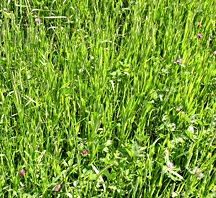Restoring a Neglected Lawn
Is it Worth Restoring?
From time to time you may need to carry out some restoration work on your lawn, either because it has suffered some neglect that has allowed weeds and moss to take over or because it has been damaged in some other way.
If the damage is too extensive, then the best option may be to clear the old lawn away and start again either by laying fresh turf or growing a new lawn from seed.
If, however, there is sufficient remaining lawn that you think it is worth saving then you need to plan for some extensive remedial work.
Overgrown Lawn
If the lawn is overgrown, then you need to bring it back to a respectable height. Depending on how badly overgrown it is, you may have to reduce the height gradually over a period of time, allowing the grass to recover between cuts. Do not leave the cuttings behind since this simply encourages thatch and moss to grow.
Next, a neglected lawn is probably short of sufficient nutrients to keep it healthy, so the next task is to feed it with a suitable lawn fertiliser and allow a few days for it to take effect.

Once the grass plants are reasonably healthy it is time to start the hard work of removing thatch and moss by scarifying. For a small lawn this may be done by hand using a spring tined rake. However, be warned that it is back breaking work and you may want to hire powered equipment if your lawn is more substantial. This work needs to be done with some care to minimise damage to the actual grass. Ideally, the grass should not be too dry or too wet for this work. The waste material that is produced can be collected and put on the compost heap.
Allow another few days for the grass to recover and then mow again, if necessary, before applying a selective weed killer specifically formulated for lawns. For best results, carefully read and follow the instructions on the container.
Thereafter you should be able to complete the work of restoring your lawn by following the standard lawn care activities.
Bumps and Hollows
It may be that through neglect, your lawn has developed some bumps and hollows that need to be evened out. If they are not excessive, the normal treatment is to spread a layer of sharp sand over the surface to fill the hollows. Don't put on too much that you bury the grass since you want it to recover and grow through the sand. Use a brush to move the sand around. For deeper hollows it may be necessary to repeat the process, allowing sufficient time for the grass to recover between applications.
In most cases, filling the hollows will effectively eliminate minor bumps, which will no longer be apparent. However, if for some reason larger bumps have developed in the lawn – perhaps caused by tree roots for example – you may have no option but to undertake some serious lawn surgery.
Identify the extent of the area of lawn suffering from the bump and assess the amount of material that needs to be removed.
Using an edging iron and spade, carefully peel back that area of lawn. It is best to undertake this work when the weather has not been unusually dry or wet so that the grass has the best chance of a complete recovery once the surgery is complete. Try also to choose a time when you are able to complete the work in a single operation since you don't want the grass roots to be exposed for too long.
If the bump is the result of tree roots or the like, these need to be removed as a priority, though you also need to consider the health and stability of the tree. Thereafter, remove enough soil to eliminate the bump.
Ensure the remaining soil is even and firm before replacing the turf that you previously peeled back. It's a good idea to ensure the area has sufficient water and a little lawn fertilizer will help the grass to recover.
After a week or so, the area should have settled down and you can review the results of your work. Once the area has been subject to normal use for a short time, you may find that you have removed too much material so that you now have a hollow area. Rather than attempting to correct this by further surgery, it is better to use the earlier process of spreading a layer of sharp sand and allowing the grass to grow through it.
This treatment should be sufficient to allow the grass to recover and produce an acceptable lawn. If there are bare or thin patches, however, you may need to reseed. Try to match the new seed to the same type of grass as the original lawn and then treat it in the same way as when growing a new lawn from seed.
Read more about Lawns |
Read more about Plants |
